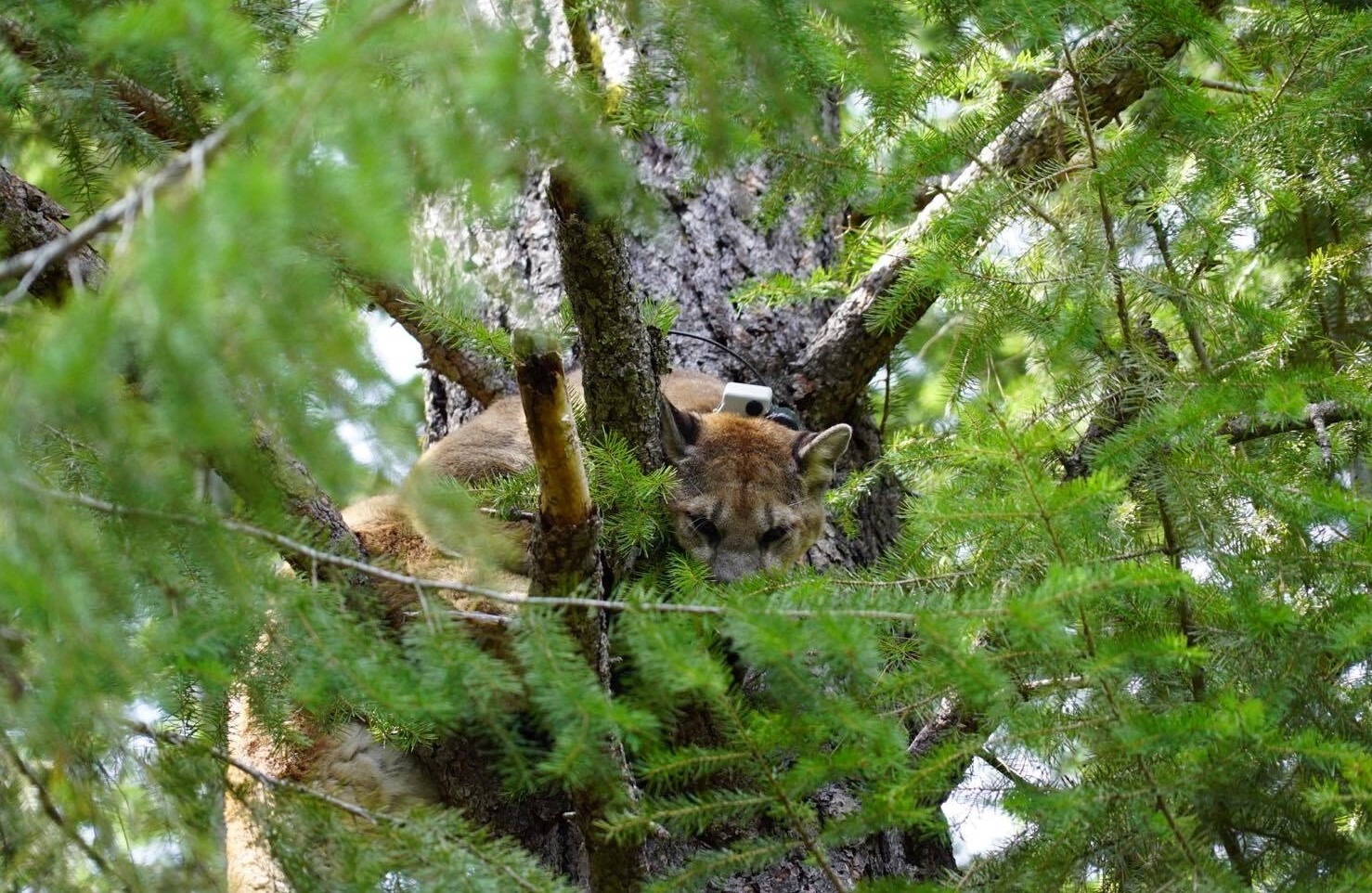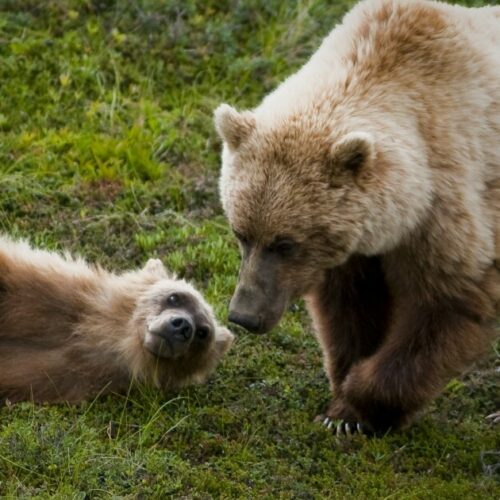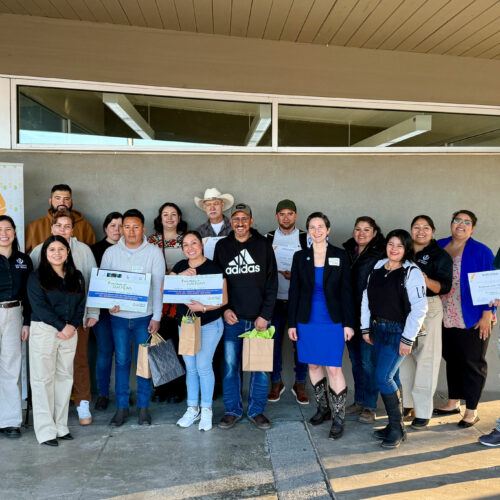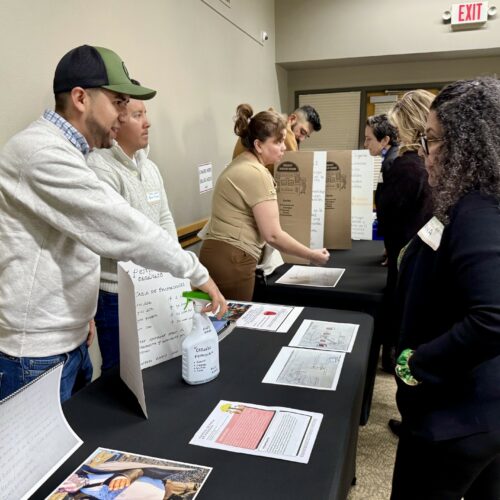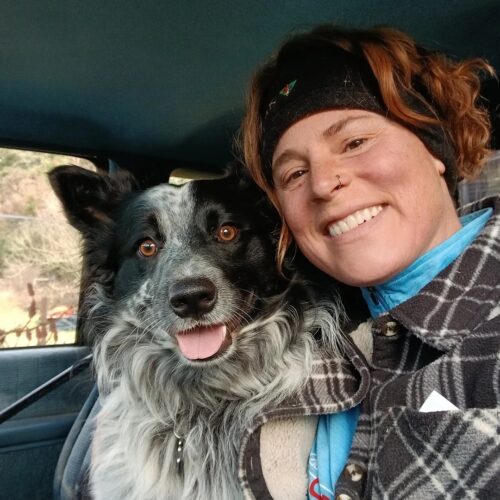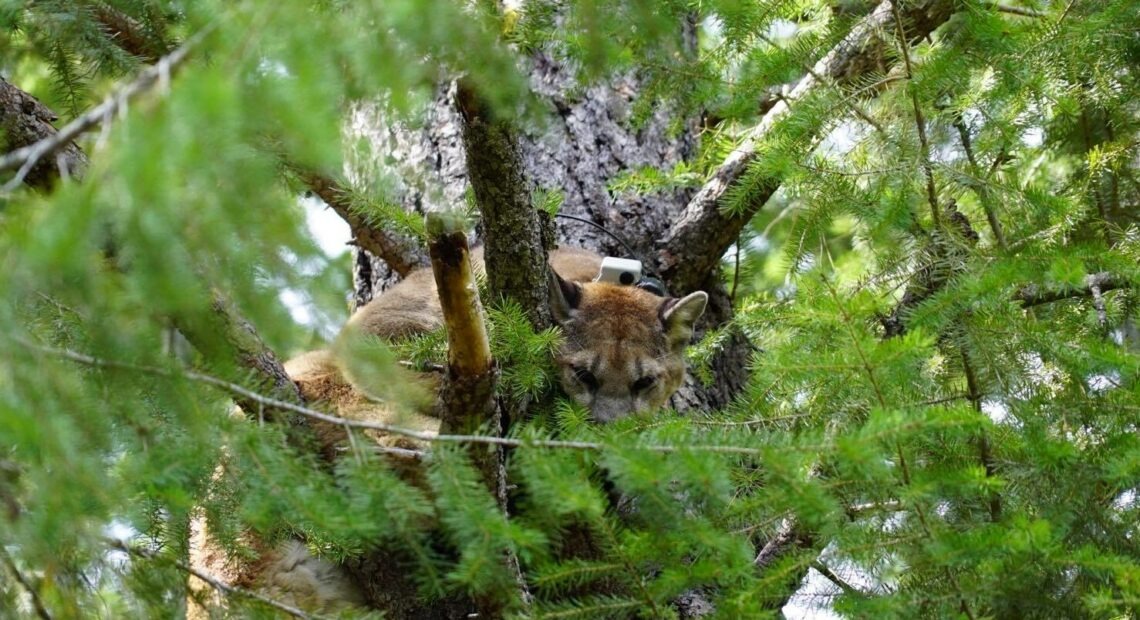
New Rule Allowing Hound Training For Cougar Tracking Highlights Wildlife-Human Challenges
LISTEN
PART 1
PART 2
In the distance comes the echo of baying hounds. They’re on the scent of a cougar. Their howls grow more frantic as the chase picks up.
Hiking behind the pack of three dogs, Bart George follows the GPS trackers on their collars. They’ve trapped a female cougar in a tree. In hound handler speak, the dogs have “treed” her.
George previously collared this cougar as part of his ongoing study as wildlife program manager for the Kalispel Tribe. Now, he’s trying to haze this 85-pound cat – through human voices and barking hounds – to reinforce an instinct to stay away from nearby neighbors and their property.
“We’re really teaching them to be wary of humans,” George says.
The cougar peers down out of the tree, at least 50-feet in the air. She waits for the dogs and people to scatter before she can make her escape.
George says his research wouldn’t be possible without the help of his hounds – Whisper, Tipsy and Boone. He’s raised these dogs and takes them out on research expeditions and state-requested hunts after cougars have killed or injured livestock, known as a depredation.
Often those attacks happen on small hobby farms. George calls this part of northeastern Washington a hotspot for the big cats.
George says the work has picked up. Often he’s taking his dogs out five days a week, sometimes to multiple calls a day.
“We all have lives outside of this, too. Like, I have a young family. (Another hound handler) runs two businesses. We have things going on that we can’t always just drop what we’re doing. But we did, and at a cost financially, missing things at home that you don’t want to be missing,” George says. “So having more people available to drop what they’re doing and go out would help.”
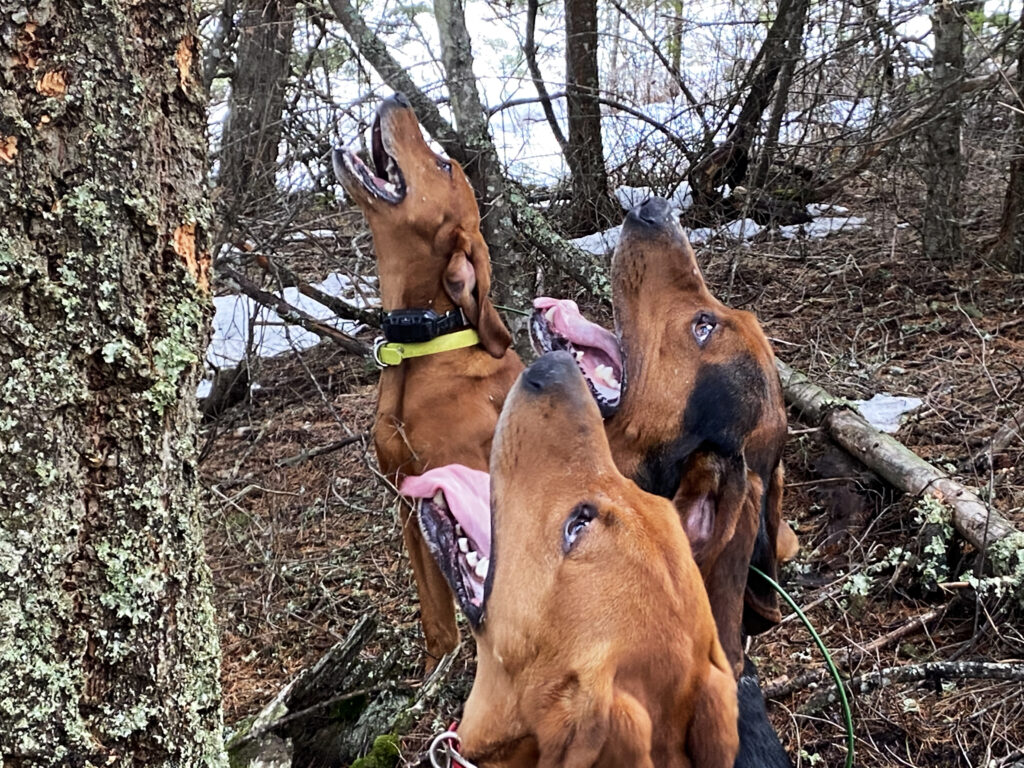
Three dogs, (from front) Kula, Rambo and Boone, surround the base of a tree where they’ve trapped an 85-pound cougar. The hounds trail the cougar and then bay at the base of the tree once the cougar is trapped. CREDIT: Courtney Flatt/NWPB
New rule
The Washington Department of Fish and Wildlife Commission recently approved a new rule that could soon grant George’s wish. But the rule is not without controversy. Many conservationists worry that training more hound handlers could put a strain on Washington’s cougar population and lead to catastrophic unintended consequences for the big cats.
In 2019, lawmakers directed the commission to create the new non-lethal cougar pursuit training pass rule. The rule would permit up to 50 people to train their dogs each year, with up to four immediate family members and a private landowner in tow, in specific geographic regions throughout the state. Hounds would be allowed to trail cougars’ scent and tree the cats. New pursuit training rules are also supposed to be drawn up for bobcats and black bears.
A 1996 voter initiative made it illegal to use hounds to hunt cougars in Washington, except in the case of attacks on livestock, pets or for public safety. The state says it needs more trained hound handlers and dogs so that it can capably respond to calls about these attacks.
“Part of the reason for needing to train on live (cougars) is so that it does happen in a humane manner. Because when a dog that is hardwired-DNA only gets to turn loose to do something once or twice a year, they are not under control and they are not calm. It will become inhumane to the animal that they’re pursuing,” WDFW commissioner Molly Linville, a rancher in Central Washington’s Palisades, said at the Jan. 29 commission meeting.
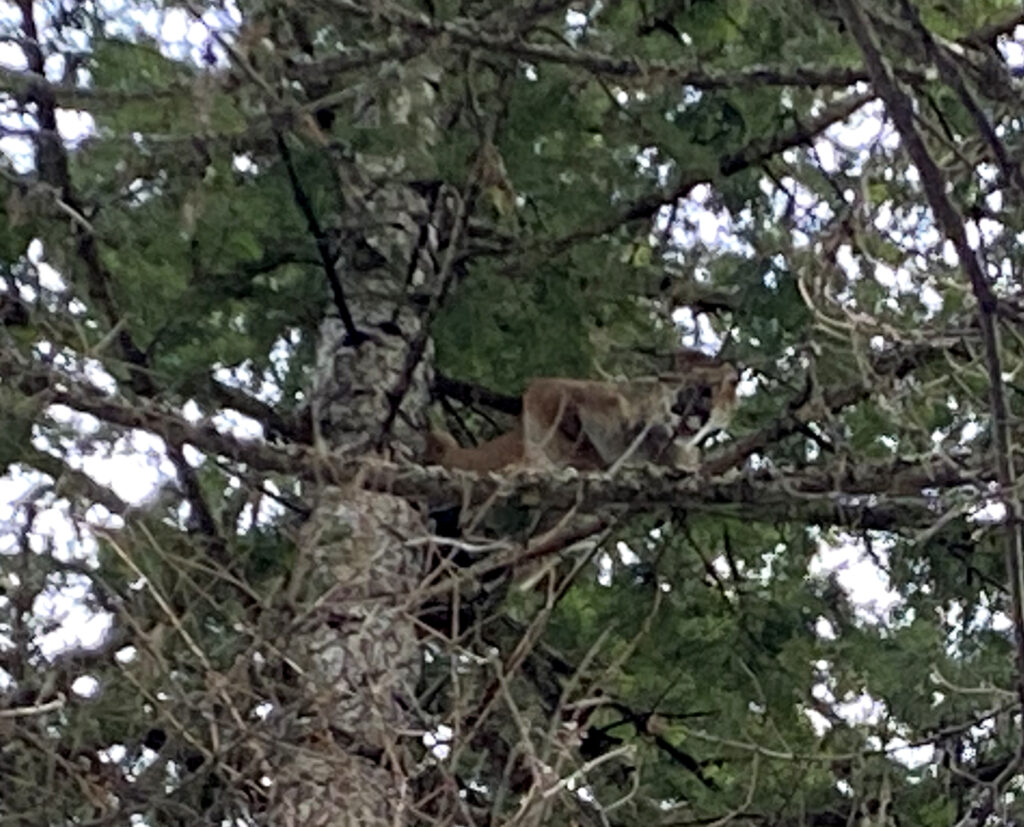
Hound handlers have trapped an 85-pound female cougar in a tree, near the reservation of the Kalispel Tribe in northeastern Washington. This cougar is part of a study the tribe is conducting to haze cougars, making them wary of human interactions. CREDIT: Courtney Flatt/NWPB
After lengthy oral public comments – mostly against the rule, many of which asked the commissioners to put off a decision for further study – some commissioners suggested taking a few months to tweak the language. Many other written comments supported the rule.
“This program, of course, isn’t just going to be pursuing problem animals. Most predators and most large carnivores never cause problems. Imagine if that wasn’t the case. So we’re going to be pursuing cats that aren’t problem cats and don’t really need that lesson, per say,” said commissioner Lorna Smith, the former executive director of Western Wildlife Outreach.
WDFW Capt. Jeff Wickersham would help enforce the new rule in southwestern Washington, where many tense cougar issues have popped up.
“It’s very obvious that there needs to be some very strict limits and controls on this. And I hear that loud and clear,” Wickersham said at the meeting.
Elusive cats, difficult study
Now that the rule is in place, there needs to be considerations for how it’s implemented, says Mark Elbroch, puma program director for Panthera, a wild cat conservation organization. He’s studied cougars – also known as pumas, panthers or mountain lions – for nearly 20 years.
Elbroch, who supports the hound pursuit training, says there should be a list of requirements to participate in the program. For example, handlers could have a mentor. He says handlers who receive pursuit training passes should want to contribute a service to their communities, not just be in it for the hunt.
“Those people already exist in Washington. If we’re going to create a program, we want it done well. I’ll be the first to criticize it, if it’s done poorly,” he says.
It’s hard to know exactly how many cougars are in Washington. The cats are elusive and difficult to study. A lot is still unknown, which can complicate management and policy decisions. After long-term research, WDFW estimates Washington could have up to 2,100 cougars older than 18-months, the oldest age the cats start to live independently.
Watch a quick video I made. Hounds Kula, Rambo and Boone, surround the base of a tree where they’ve trapped an 85-pound cougar. (9/12) pic.twitter.com/KRqGEYG9zp
— Courtney Flatt (@courtneyflatt) February 24, 2021
Elbroch says it’s unclear whether more cougars sightings mean there are more animals or more people spending time in cougar territory.
He says the cougar trend in Washington is fairly unknown, which leads to a lot of speculation. Instead, he says populations should be managed so ecosystems are healthy, people feel safe and aren’t worried for their livestock.
“I would love to see people shift their angst and discussion and debate to: What do we need to maintain a healthy ecosystem and healthy human communities? Where’s that threshold?” Elbroch says.
But that sort of management is tough. Elbroch says recent studies point to the fact that heavy-handed hunting can temporarily reduce cougar numbers, but other cats will eventually fill in those holes.
He says that type of management can also lead to a breakdown in young male cat dispersal and in-breeding.
“There is clear evidence that younger cats are more likely to have a negative interaction with people, he says. “Meaning threaten people on hiking trails or appear in their backyard to kill a dog, to kill a sheep. All of those things are more likely to occur if it’s a young cat. And it’s way more likely to occur if it’s a young cat that’s hungry – and dispersers usually are.”
That’s one reason he says harvest quotas should be reduced.
But, this new hound training rule? Elbroch says it’s necessary. He says, for now, there has to be a middle ground – between those who want all cougar hunting abolished and those who need protection when their livestock or pets are killed by cougars. That middle ground is hound handlers.
He says it might seem counter-intuitive, but hound handlers are often “allies for (cougars) across the West.” They’re out there 300-plus days a year, Elbroch says, working for the state, for researchers, and on the rare human-safety case.
“I think wildlife advocates don’t want to hear this, but it’s true that hound hunters become advocates for species. Not all of them do. Of course, there are bad eggs and good eggs and some of them don’t give a crap about mountain lions,” Elbroch says. “But there are many who fight for that species.”
Fighting for the rule
One hound handler who strongly advocated for this rule is Buddy Woodberry. He began training hounds after a trip to Texas more than 20 years ago. A friend had found a stray hound, but couldn’t find the owner. So Woodberry eventually took his first hound home to Washington.
Woodberry started off hunting raccoons and some bears. Then he got into working with the public safety pilot programs for cougars with WDFW. “That kind of got me tied into cats,” he says.
Now, he trains his hounds from pups. At first, just letting them inside, getting them house-trained. Then, around six-months-old, the dog is ready to head into the woods with the older hounds.
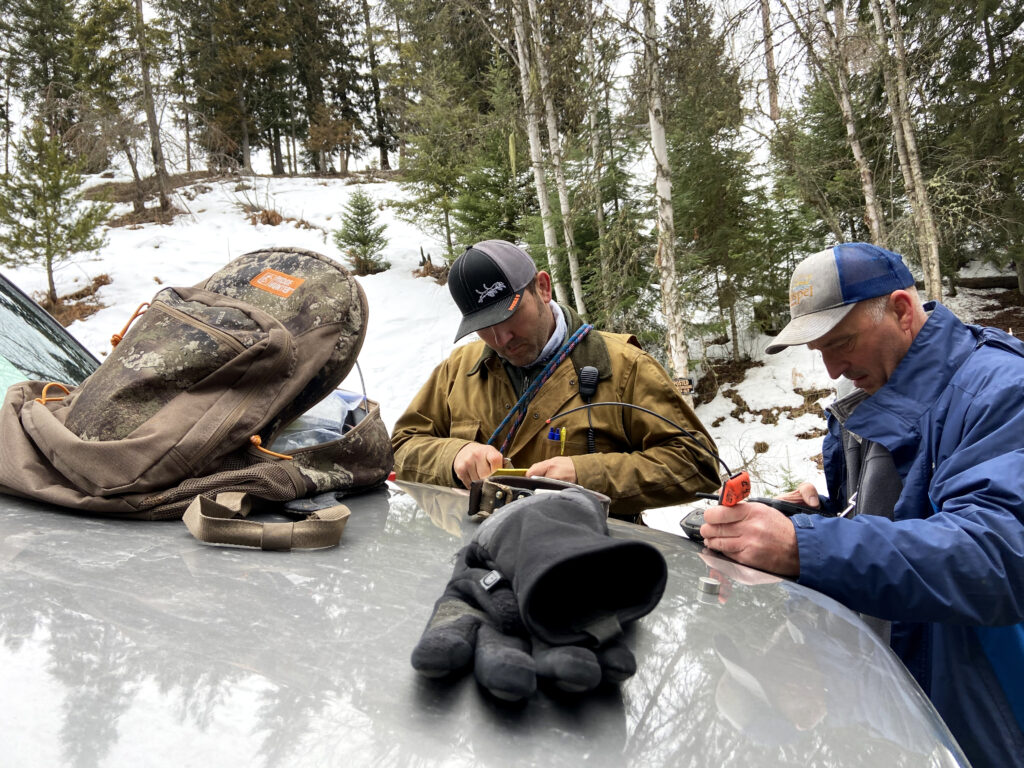
Bart George, left, and hound handler Bruce Duncan prep their equipment before they plan to collar a cougar near the reservation of the Kalispel Tribe in northeastern Washington. CREDIT: Courtney Flatt/NWPB
“It’s investigating deer and coyotes and different smells that it’s never smelled,” Woodberry said. “It’s just a process of encouraging it on the good smells you want to follow – whatever that is – and discouraging it to follow the smells you don’t want to follow: deer or coyotes or, for me, bears.”
Woodberry has helped with depredation cases and problem cougars in downtown Vancouver, Washington. But, he had to pull his dogs off cougar scents when he was training them in the state. Hound handlers could only train their dogs on cougar scents outside of Washington.
One summer, he was “roading” his dogs – running them along a wooded road to help them build stamina. Then, they smelled a cougar, which they weren’t legally allowed to follow.
He pressed a button that emits a tone on the dogs’ collars. The tone calls them back their handler.
“I call them. I yell at them. I have to school them a little bit like, ‘Hey, leave that alone,’” Woodberry says.
Then, once he got home, a WDFW enforcement officer called. There’s a potential cougar sighting at a park in Vancouver. Could Woodberry and his dogs check it out? (It turned out to be a housecat.)
“So I’m taking these same dogs that I just beeped, toned and maybe shocked for smelling a cougar. And I’m telling them, ‘Oh, this time I want you to follow that cougar,’” Woodberry said. “But my dogs don’t switch their mindset within two hours to go, ‘OK, now I want to follow a cougar. Now I don’t.’”
While there are hound handlers with bad raps, Woodberry says this program in Washington will create well-trained dogs and people.
“I don’t do this to catch cougars. I do this to work with my dogs. To get closer to my dogs and to watch a pup or a young dog start to open up and start to learn,” he says. “You watch this progression kind of like you watch your kids.”
But some people worry that’s not going to be the case with all hound handlers – and the outcomes could be much more devastating for cougars.
Worries over new rule
Debra Chase, with the Mountain Lion Foundation, worries this rule allows too many hound handlers, that family members can join the training and that handlers are allowed to carry weapons. She says this could open the door to reinstating hound hunting for cougars in Washington.
“It’s, really, reinstating hound hunting for just a select number of people, and that’s what we’re trying to stop,” Chase says. “(Hound hunting is) more than cruel. It’s kind of sadistic in a way, I think. Let’s say that the trainer goes out with his hounds, and he chases a female up the tree and they don’t call the dogs off right away. She’s going to stay up that tree for quite a while. She doesn’t get to drink or eat, and neither do her cubs.”
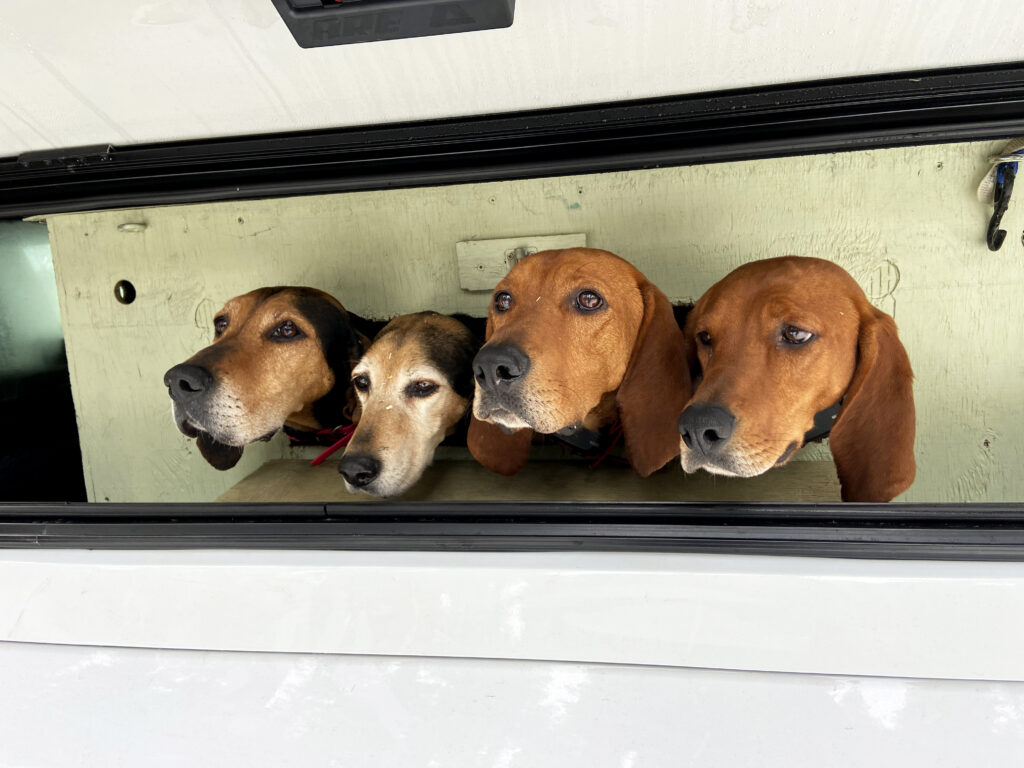
Hound handlers keep their dogs, Tipsy, Whisper, Boone and Kula, in the back of their trucks, waiting to track the scent of a cougar in northeastern Washington. CREDIT: Courtney Flatt
Chase says it was irresponsible of the WDFW commissioners to push through this hound training program. She argues that this training could be done in a different way, one that’s safer for the cougars, the dogs and their handlers. (Hound handlers and some researchers say that’s not the case.)
“Hounds are used in other types of ‘sniff and track.’ Take hounds that are trained to find human cadavers. They’re trained to use scent to find a human cadaver, and the same thing could be done with wild animals,” Chase says.
She says you could saturate some cloth with the urine or the scent of a cougar and trail it through the woods or tie it behind a four-wheeler. The dogs could follow that scent. She says exercising a dog doesn’t have to be with a live cougar.
Or, says wildlife biologist and tracker Rosemary Schiano, you could boost the state’s Karelian Bear dog program to help with depredation incidents. Schaino, who often gives cougar presentations with the Mountain Lion Foundation, says she’s worried WDFW is “taking wildlife policy backwards.”
“This is an enormous concern for wildlife harassment, the harassment of already stressed cougars,” Schiano says. “The other thing is, to be honest, I’m extremely concerned that this is going to create more conflict.”
Hazing with dogs has to be done in what Schiano calls a “proper manner.” She says you must tie the hazing to a specific unwanted behavior, like going onto personal property, near livestock. Or, she says, you could professionally train hound handlers to work as hazing teams and not tree the cougars.
She also believes handlers shouldn’t carry firearms.
Schiano would like to see hound hunting eliminated everywhere. States could switch to completely non-lethal protection methods, which would mean people would have to be responsible for their families and property. They would have to install preventative devices, like fencing that can’t be easily jumped, and other aversion methods, like equipment with lights and sounds. She says it’s all about educating homeowners and recreationalists.
Cougars, Schiano says, are just being cougars. They don’t know that they shouldn’t be chomping away at hobby farms or hanging along hiking trails.
“So basically, you’re killing the victim. It’s like, ‘Oh, let’s look at the symptom instead of going for the cause,’” Schiano says. “ Conflicts, I would like to stress, are human created. They are not created by the predators, by what we call large carnivores.”
California to Klickitat County, Washington
Both Chase and Schiano say the exemplary state to look to is California, with its progressive cougar policies. The state will only kill a cougar if it’s an imminent threat to human life. In 1990, voters approved an initiative prohibiting cougar hunting, establishing the cats as a “specially protected mammal.”
Wildlife advocates say that’s far from the case in Washington. One prime example of threats to the cats is in Klickitat County, where the sheriff has gathered a posse to deal with “problem cougars.”
In 2019, the Klickitat County Sheriff’s Office reported multiple cougar sightings in “Goldendale, White Salmon, Glenwood, Husum, and other neighborhoods throughout Klickitat County.”
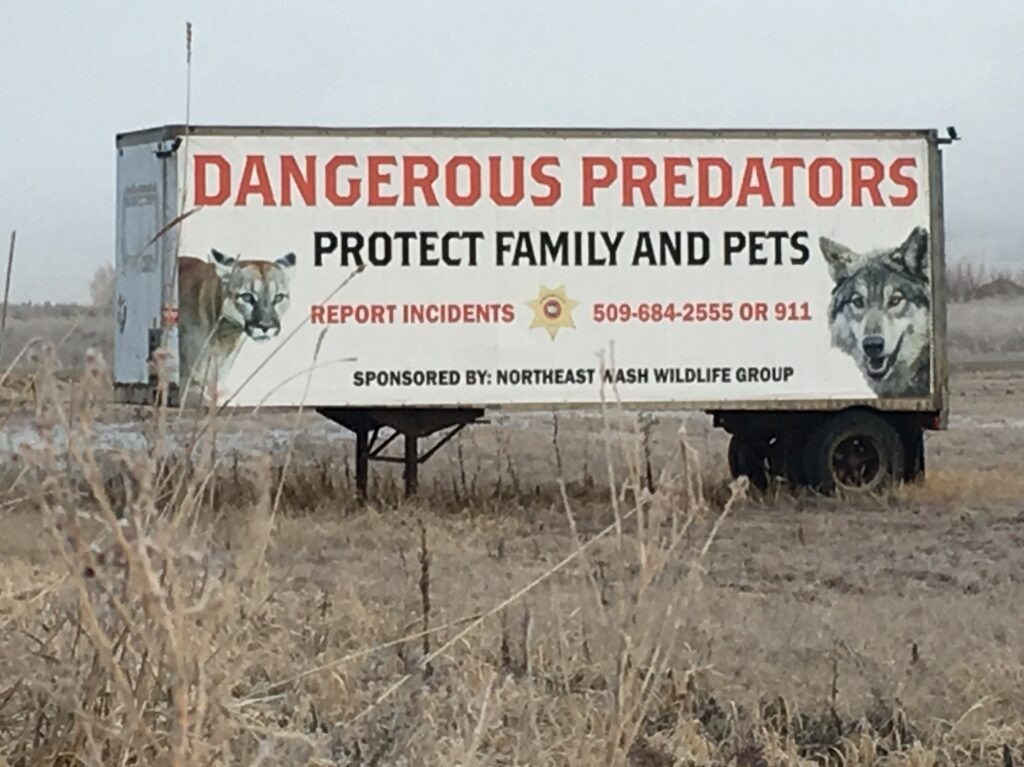
A sign on the side of a trailer in Stevens County, Washington, near Chewelah off U.S. Highway 395 prompts people to report “dangerous predators” like cougars and wolves. CREDIT: Scott Leadingham/NWPB
“This is a serious PUBLIC SAFETY CONCERN,” Sheriff Bob Songer wrote on Facebook. “In addition to the Public Safety Concern, cougars and bears are a major concern and a problem for the farmers and ranchers in our County. Livestock and Domestic Animals are being killed by cougar (sic) and bears in our county on a regular bases (sic).”
In response, the sheriff established a program to authorize volunteer deputized hound handlers and sheriff’s deputies to be the “the Primary Response to Wildlife-Human Conflicts involving Dangerous Wildlife,” including cougars and black bears. About five hound handlers are part of the sheriff’s roughly 140-member posse.
A deputy and hound hunters are dispatched “to all reported dangerous Wildlife conflicts that is a (sic) risk to human safety or domestic pets and livestock.” The hounds are authorized to track down the “dangerous animal” to be euthanized. Hound handlers are supposed to cut off the dead cougars ears so it can’t be used as a trophy kill.
“Apparently what some of these people are talking about – that we’re just running around out there, hunting cougars down with our posse members for trophies – that is a flat lie,” Songer said in a phone interview with Northwest Public Broadcasting. “In fact, in our policy, if we had an employee or a volunteer that violates that law, they will be facing a lot of trouble. … We’re not out to shoot cats.”
In response to pushback on its Facebook post, the sheriff’s office replied, “We will not be out killing every dangerous animal that is out there. We will deal with the ones that pose a threat.”
But wildlife advocates say that’s exactly what’s happening.
They worry Klickitat County’s public safety issue is taken way too liberally. According to multiple call logs from the sheriff’s office and deputy reports, deputies and hound handlers were dispatched after a goose was killed near a house, as a cougar was seen exiting a sheep pasture, as one laid under a treehouse, after a cougar was seen sitting on a rock 60 feet from a house and after a cougar was spotted when a neighbor took a walk.
Not all of the cats were killed. Often the tracking dogs could not find a cougar scent.
Klickitat County Cougar 911 Reports – 2020 by NWPB News on Scribd
Some complainants were advised to call 911-dispatch more quickly upon cougar sightings. The hound handlers have also been called out to possible bear and bobcat sightings.
According to data given to Northwest Public Broadcasting, Klickitat County hound handlers were called out at least 63 times over 2019 and 2020. In that time, at least 19 cougars were killed.
Of those cougar kills:
– At least nine of the cougars were killed with little to no reported evidence they had attacked other animals, although several of the cats were observed near livestock.
– At least three cougars were killed after they were seen eating a deer, the most common prey for the big cats.
“When people see a cougar, they’re calling the sheriff’s department,” says Gabrielle Gilbert, who lives near White Salmon in Klickitat County.
Tips/comments/feedback: Email here
Songer says the cougar calls have dropped off significantly in recent months. “At one point, we were getting calls left and right,” he says.
The sheriff says it’s his job to protect livestock and pets, and especially people, who he says could be injured by cougars in town.
He pointed to an incident in 2020, where a cougar got into a 4-H goat pen at Columbia High School in White Salmon, killing four goats and dragging another away. On the second day of tracking, they killed the cat.
“Point I’m making is that if you’ve got (a cougar) killing goats on school property, I mean, that goat could have been a kid, just as easy,” Songer says.
“A death warrant”
Washington state’s 1996 ban on hunting cougars with hounds has an exception to protect livestock, pets, private property or public safety. Gilbert says the Klickitat County Sheriff’s Office is abusing those exceptions through a “public safety loophole.”
Bart George records the distance of a female cougar he is hazing as part of a study for the Kalispel Tribe. George says each time he hazes a cougar, it flees farther away. CREDIT: Courtney Flatt/NWPB
“I mean, it’s a death warrant (for cougars),” she said.
Gilbert says Klickitat County’s emphasis on cougar kills could become the pervasive attitude in the state, as more people are trained to track cougars with hounds. She says it was a “hard blow” for the WDFW commission to not table its decision on the training rule for further study.
“You are not only in Klickitat County dealing with those results. You are dealing with it if it spreads to other counties in the state. And that’s the cautionary tale,” Gilbert says.
She wants to see policy changes at WDFW so this loophole is closed and the “blatant abuses in Klickitat County aren’t allowed.”
Northeastern Washington
Driving down a one-lane highway near Ione, Washington, biologist Bart George says he sees the new rule allowing more training for hound-tracking as a way to help the state’s response to safety and livestock concerns.
He turns his pickup onto a side road, up a snowy hill. The dogs in the back of the truck know they’re about to work. They begin to howl and whine. This time, they’re looking for a cougar that’s been reported in town. George hopes to collar it as a part of his study.
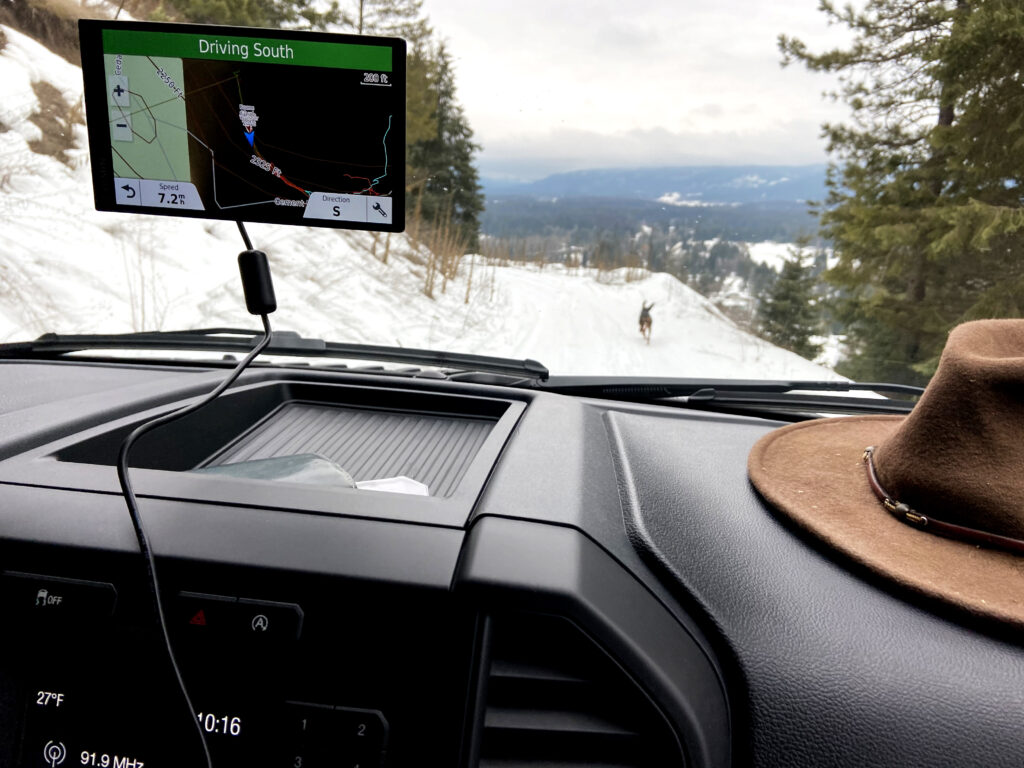
Bart George follows the hound Rambo as he searches for a cougar scent, near the town of Ione, Washington. George is able to track Rambo every two seconds, with the help of a Garmin GPS attached to the dog’s collar. The Garmin transmits data to George’s navigation device. CREDIT: Courtney Flatt/NWPB
“We need a real world opportunity to train our dogs on live cougars. Without that, you just can’t expect them to know what to do and how to respond when they are needed on a depredation,” George says. “We wouldn’t expect police dogs to go without training. We wouldn’t expect drug dogs to smell anything other than real drugs. They get trained on the smell of drugs.”
George says people in this part of rural Washington are nervous. They need to be educated about the big cats, which he says are everywhere. Residents need to learn how to better protect their livestock and pets – something he tries to teach.
In fact, as the team treed a cougar they’d been tracking with GPS, four neighbors heard the dogs baying and came over to see what was going on.
“You saw the landowner show up,” George says. “He had his gun in his hand. He was nervous. It’s a good opportunity for them just to see a cat in a non-threatening place. Learn a little bit about it. There are things that he can do to button his place up a little bit to protect his pets. There are also things that, hopefully, we can do by hazing that cat, giving it some kind of healthy fear of human interaction.”
George says people have made it easier for cougars to be tempted by our livestock and pets.
“We’ve created this situation where the deer live down in the valleys, and the cougars don’t have a choice but to come down to the valleys, where the people are, to hunt,” he says. “So now we just have to figure out how to coexist to some degree.”
Courtney Flatt covers environmental and natural resources topics for NWPB. She is based in the Tri-Cities. On Twitter: @courtneyflatt
Tips/comments/feedback: Email here
Related Stories:
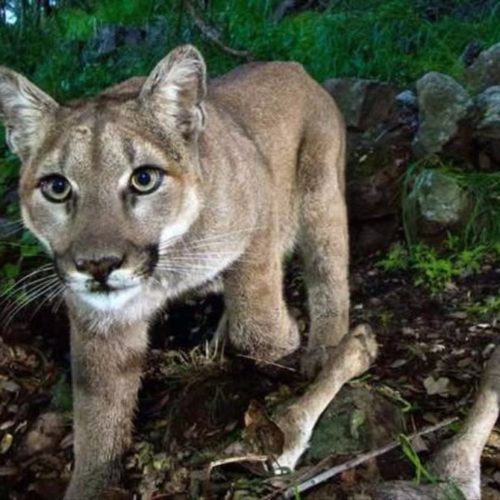
Are There More Cougars In Our Space Or More Of Us In Theirs?
It’s hard not to notice that cougars are making it into the news these days. It’s also hard to miss how they’re getting there: by entering neighborhoods and putting residents on edge.

Oregon May Be Over-Hunting Cougars — Which Could Cause More Conflicts
Groups of Oregonians, particularly hound hunters, say that Oregon’s cougar population is growing out of control. Cougar advocates, on the other hand, say that Oregon is over-hunting cougars, which research suggests can lead to an increase in problem encounters.
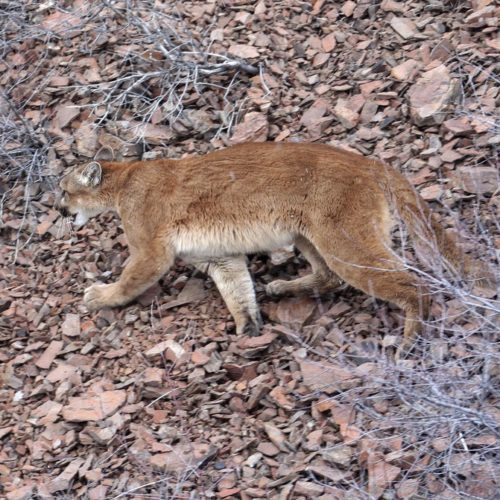
Hunt Planned For Cougar Suspected Of Killing Oregon Hiker
The search is on for the cougar suspected of killing a hiker near Mount Hood. It is the first confirmed fatal attack by a wild mountain lion in the state. The Oregon Department of Fish and Wildlife plans to use mules and dogs to search for the mountain lion.

